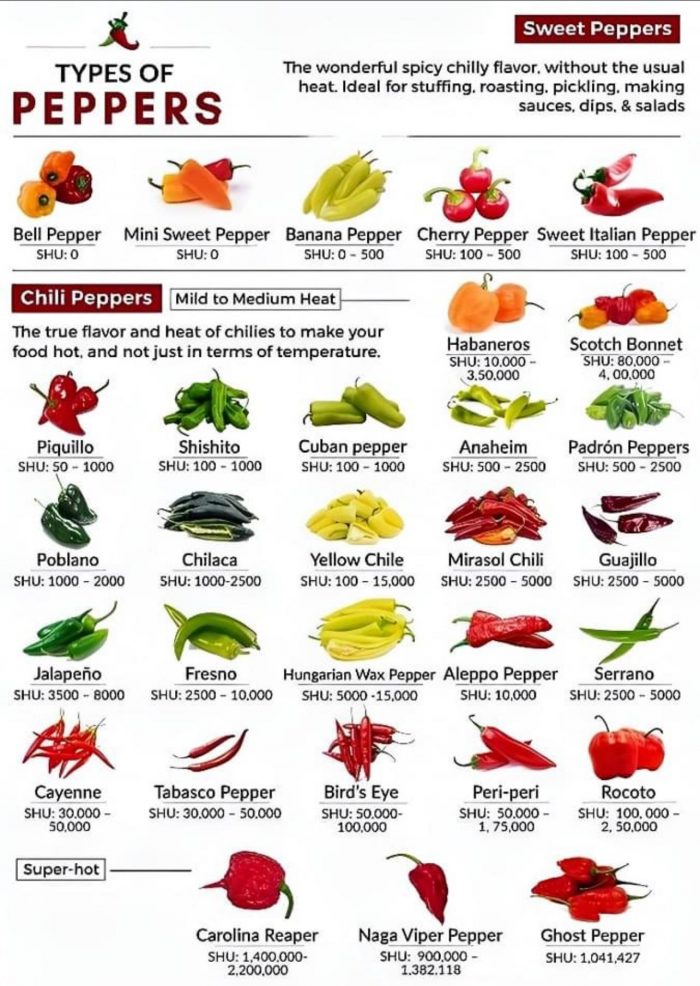
Peppers are among my favorite foods. They’re versatile, tasty and easy to store. They make for great snacks, flavorful additions to meals and can be used in a wide variety of dishes from all over the world. Peppers come in many shapes, sizes and colors—and each one has its own unique flavor profile (and heat level). You might think that all peppers are created equal, but they’re not! Here’s a breakdown of some common pepper varieties found at your local supermarket:
Bell Pepper
Bell peppers are a common ingredient in many cuisines, and you’ll find them used raw, grilled or roasted in dishes all over the world. They come in a variety of colors, including green (the most common), red and orange. Purple bell peppers are less common but still widely available at most grocery stores.
Sweet Italian Pepper
Sweet Italian peppers are a type of sweet pepper that is often used in salads, sandwiches and as an ingredient in many Italian dishes. They are usually picked when they are green and then ripened off the vine. The sweet taste comes from natural sugars that develop during their growing process.
Habaneros
Habaneros are a type of pepper that grows in a variety of colors, including orange, yellow and red. They’re often used in salsas and hot sauces because they have a very high Scoville heat scale rating–the scientific measurement for how spicy something is. Habanero peppers can be dried and ground into powder form or pickled or canned whole like olives (which makes them easier to eat).
Piquillo Peppers
Piquillo peppers are a variety of sweet red pepper that are grown in Spain. They have a smoky flavor, and are used in Spanish cuisine, as well as many other cuisines. Piquillo peppers can be found fresh or canned in jars; these will keep for up to one year if unopened, but once opened they should be stored in an airtight container and used within two weeks.
Anaheim Chiles
Anaheim chiles are a mild pepper that originated in the Anaheim, California area. They are a long, slender pepper that is typically green and ripens to red. Anaheim chiles have a mild flavor, but can be used in salsa or cooked as well as raw.
Guajillo Chiles
Guajillo chiles are a deep red color and have a sweet, mild flavor. They are milder than the jalapeno pepper, but can still pack a punch if you’re not used to spicy foods. Guajillo chiles are usually used in soups and stews as well as sauces like mole (a traditional Mexican sauce).
Jalapeños peppers
Jalapeños are a type of chile pepper that originated in Mexico. They’re also called “jalapeño peppers” or “pickled jalapeños,” but no matter how you refer to them, they’re a staple of Mexican cuisine and widely used in other cuisines as well. Jalapeños are hot, but not as hot as habaneros (the hottest type). They have a distinct fruity flavor that’s quite different from other peppers like bell peppers or chili peppers–plus they tend to be more colorful!
Tabasco peppers
Tabasco peppers are often used in Cajun and Creole cuisine. The thin-skinned peppers produce a flavorful, mild to medium heat when fully ripe. Fresh Tabasco peppers are only available from June through September and can be found at Farmers Markets, specialty grocery stores and some supermarkets across the country. The Tabasco pepper is also known as a variety of chili called “taba” which means “to pickle” in the language of its native land: Mexico! There are many different types of chilis grown throughout Central America (including Mexico), but none have quite as much notoriety as this one does thanks to its use as a condiment by early settlers who brought it back home with them after their travels through Louisiana where they discovered this delicious ingredient while dining out on spicy foods like gumbo or jambalaya dishes made with local seafood such as shrimp or crawfish tails along with other vegetables such as okra pods – both ingredients commonly used today when making traditional recipes passed down through generations over time since their creation during colonial times.”
Aleppo pepper
Aleppo pepper is a type of pepper that comes from Syria, Turkey, and other parts of the world. It has a mild flavor with a hint of sweetness. Aleppo peppers are often sold whole and their seeds can be easily removed without tearing the skin (which is typically around 3/4 inch thick). You can also use its crushed form if desired.
So, what does all this mean? Well, it means that there is a pepper for everyone! Whether you’re looking for something spicy or mild, there are many varieties and flavors to choose from.
